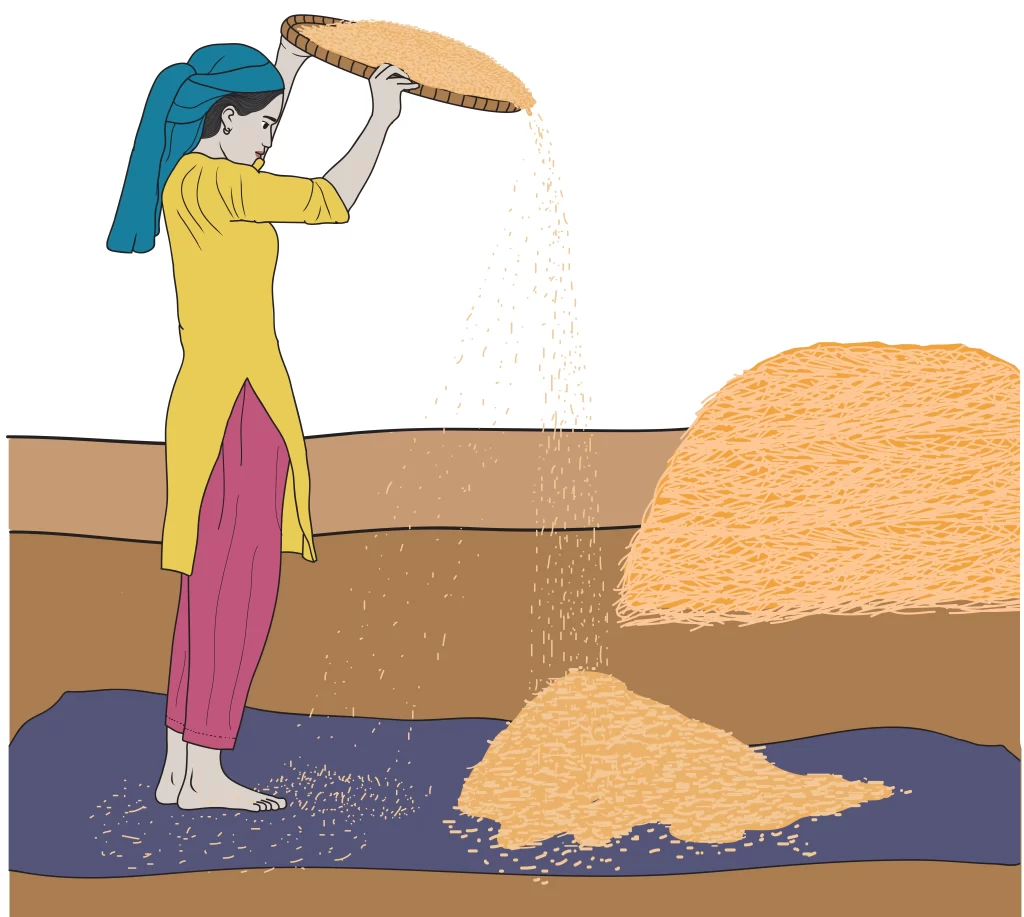Introduction
Various important materials in our daily life remain in a form of a mixture. So, for proper utilization of that element, we need to separate them. Depending on the nature of the materials, they are separated using a different procedure. There are different separation techniques like hand-picking, sieving, filtration, winnowing, and threshing, etc. In the winnowing process, heavy particles are separated from the lighter ones using blowing wind. In our daily life, the mixture of wheat and husk is separated by the winnowing process.
Define the Winnowing process
- Heavy materials are separated from lighter substances using the wind.
- The grains of rice and wheat are separated from their husks by this method.
- The mixture of grain and husk is taken in a sieve and shovel and put down from a height to the ground level. The force of wind causes the heavier grains to settle down to form a heap while the lighter husk elements are pushed aside.
The basic principle of the winnowing process
This process works based on the differences in mass between two substances that will be separated. Lighter particles are separated from heavy particles using this method. As the weight of heavy particles is higher than the lighter particles, they gather up on the surface in the shape of a heap. And the lighter particles are pushed away by the wind.
Techniques used in winnowing
- Winnowing separates rice or wheat grains from the chaff and husks using strong winds. Farmers would throw rice from a height and wait for several hours for the air to blow before separating the rice grains from the chaff with the help of shovels or sieves.
- The development of a winnowing machine coincided with the globalisation of industry. Today, farmers may pedal to alter the wind speed created by wind winnowing equipment. Farmers no longer need to depend on the wind to blow. They can winnow an unlimited amount of paddy or rice in a short amount of time. Farmers can utilize them even during the rainy season as the equipment can be operated inside of a sizable confined environment. We may purchase numerous winnowing machines on the market today.
- A winnowing fan, a special-shaped basket for shaking grains, harnesses the wind to separate lighter grain particles. Modern winnowing fans can be made of many different materials, such as paper, bamboo, or cane fans that can create wind from nothing.
- Using a device like a pitchfork, a winnowing fork also employs wind to separate grain chaff. When the grains from the fork are winnowed, the chaff is blown away and the grains that fell to the ground are gathered by the farmers.

Advantages of winnowing
- Winnowing is an essential part of farming production, particularly in paddy fields.
- Husks can be fed to cattle if they separate from grains.
- The machinery used for winnowing is simple to use.
- This method is inexpensive.
- There is no requirement for fuels because they generate wind using pedal power.
- The winnowing technique is an environmentally-friendly method.
- It facilitates getting rid of husks that are indigestible to people.
Disadvantages of winnowing
- It does not apply to mixtures with heavy particles or mixtures in which all of the components are the same size. Winnowing is thus only appropriate for mixes in which one component is lighter compared to the other.
- For removing stone particles, winnowing is not appropriate.
- Substances that are heavier than grains cannot be winnowed.
- Lighter particles are removed during the winnowing process by blowing air across them. When there is no wind on a particular day, winnowing is challenging. This is the drawback of manual winnowing.
Summary
The method of winnowing involves using the wind to separate light and heavy materials. The mass difference between heavy and light particles is the key factor in this process. Winnowing is a procedure that facilitates removing the husk from grains like rice or wheat. It can be employed to separate the husks from millet, wheat, rice, and corn. Substances that are denser than grains cannot be winnowed.
Frequently Asked Questions
1. What is sieving? Where is it used?
Ans: Use of a sieve, a tool found in flour mills and construction sites, is required for the sieving process, which involves separating smaller particles from bigger particles. By applying sieving in the mill, small stones and husks can be removed from the flour. This technique can be used to separate sand from pebbles and stones.
2. Can we consume grains directly after winnowing?
Ans: After winnowing, we cannot eat grains straight. Because winnowed grains may still contain small stones or other particles even after the husks have already been removed. So, it is best to hand-pick these stones out of the winnowed grains.
3. Why is threshing so important before winnowing?
Ans: Threshing is the process used to separate grains from their surrounding husks and straw. After reaping, this treatment should be carried out before the winnowing procedure. Any delay after cutting and threshing allow the grains to quickly deteriorate while the harvest is drying in the field or when it is heaped in the fields.

